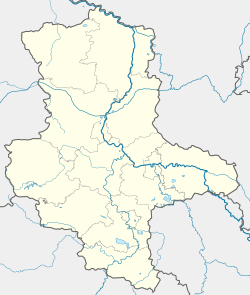 Global Information
Global InformationMagdeburg information
Magdeburg
Meideborg (Low German) | |
|---|---|
City | |
     From top, left to right: Aerial view to a part of the city centre – Town Hall – "Green Citadel" – "Millennium Tower" – Magdeburg Cathedral at night – and panorama: city wall | |
 Flag  Coat of arms | |
Location of Magdeburg  | |
 Magdeburg  Magdeburg | |
| Coordinates: 52°07′54″N 11°38′21″E / 52.13167°N 11.63917°E | |
| Country | Germany |
| State | Saxony-Anhalt |
| District | Urban district |
| Subdivisions | 40 boroughs |
| Government | |
| • Mayor (2022–29) | Simone Borris [de][1] (Ind.) |
| Area | |
| • Total | 201.03 km2 (77.62 sq mi) |
| Elevation | 43 m (141 ft) |
| Population (2022-12-31)[2] | |
| • Total | 239,364 |
| • Density | 1,200/km2 (3,100/sq mi) |
| Time zone | UTC+01:00 (CET) |
| • Summer (DST) | UTC+02:00 (CEST) |
| Postal codes | 39104–39130 |
| Dialling codes | 0391 |
| Vehicle registration | MD |
| Website | magdeburg.de |
Magdeburg (German: [ˈmakdəbʊʁk] ⓘ; Low German: [ˈmaˑɪdebɔɐ̯x]) is the capital of the German state Saxony-Anhalt. The city is situated at the Elbe river.[3]
Otto I, the first Holy Roman Emperor and founder of the Archdiocese of Magdeburg, was buried in the city's cathedral after his death.[3] Magdeburg's version of German town law, known as Magdeburg rights, spread throughout Central and Eastern Europe. In the Late Middle Ages, Magdeburg was one of the largest and most prosperous German cities and a notable member of the Hanseatic League. One of the most notable people from the city is Otto von Guericke, famous for his experiments with the Magdeburg hemispheres.
Magdeburg has experienced three major devastations in its history. In 1207 the first catastrophe struck the city, with a fire burning down large parts of the city, including the Ottonian cathedral.[4] The Catholic League sacked Magdeburg in 1631,[3] resulting in the death of 25,000 non-combatants, the largest loss of the Thirty Years' War. During World War II the Allies bombed the city in 1945 and destroyed much of the city centre. Today, around 46% of the city consists of buildings from before 1950.[5]
After World War II, the city belonged to the German Democratic Republic from 1949 to 1990. Since then, many new construction projects have been implemented and old buildings have been restored.[6] Magdeburg celebrated its 1,200th anniversary in 2005.
Magdeburg is situated on Autobahn 2 and Autobahn 14, and hence is at the connection point of Eastern Europe (Berlin and beyond) with Western Europe, as well as the north and south of Germany. For the modern city, the most significant industries are: machine industry, healthcare industry, mechanical engineering, environmental technology, circular economy, logistics, culture industry, wood industry and information and communications technology.[7][8]
There are numerous cultural institutions in the city, including the Theater Magdeburg and the Museum of Cultural History. The city is also the location of two universities, the Otto von Guericke University Magdeburg and the Magdeburg-Stendal University of Applied Sciences.[9]
- ^ Mayoral election results, 2022, accessed 4 October 2022. (in German)
- ^ "Bevölkerung der Gemeinden – Stand: 31. Dezember 2022" (PDF) (in German). Statistisches Landesamt Sachsen-Anhalt. June 2023.
- ^ a b c Chisholm, Hugh, ed. (1911). . Encyclopædia Britannica. Vol. 17 (11th ed.). Cambridge University Press. p. 301.
- ^ "Brandkatastrophen und deren Bedeutung für die Verbreitung gotischer Sakralarchitektur" (PDF). archiv.ub.uni-heidelberg.de (in German). Jens Kremb. Retrieved 28 January 2023.
- ^ https://zensus2011.de/SharedDocs/Downloads/DE/Publikationen/Aufsaetze_Archiv/2015_12_NI_GWZ_endgueltig.pdf?__blob=publicationFile&v=4
- ^ "Bilanz zum Stadtumbau". magdeburg.de (in German). Magdeburg. Retrieved 6 January 2023.
- ^ "Key industries". www.magdeburg.de. Retrieved 26 November 2022.
- ^ "The paper industry in Saxony-Anhalt". www.saxony-anhalt.com. Retrieved 26 November 2022.
- ^ "Hochschule Magdeburg-Stendal". hs-magdeburg.de.